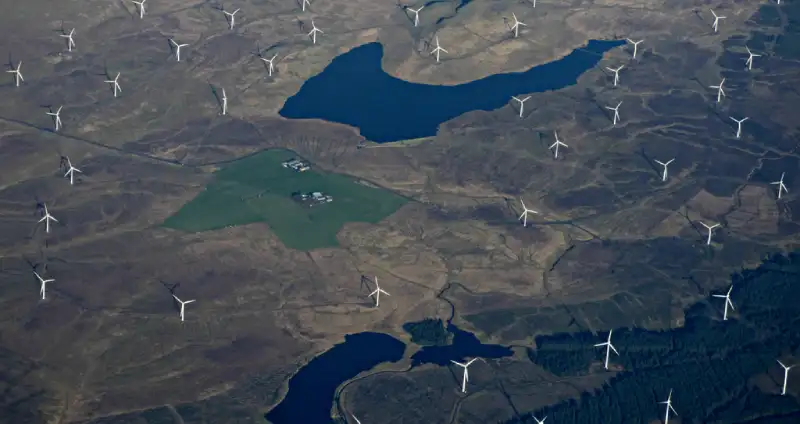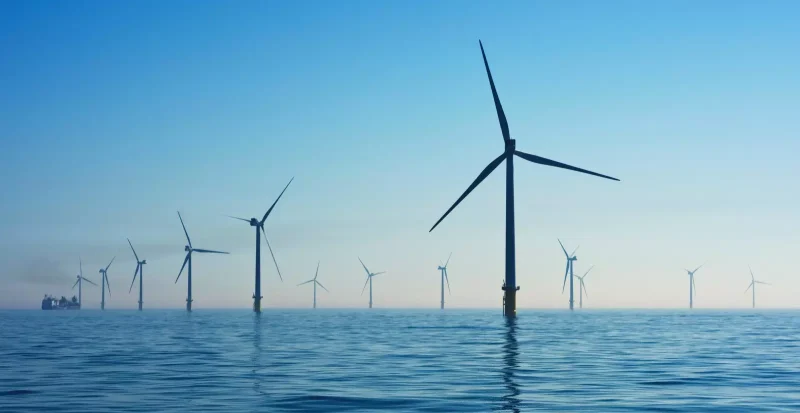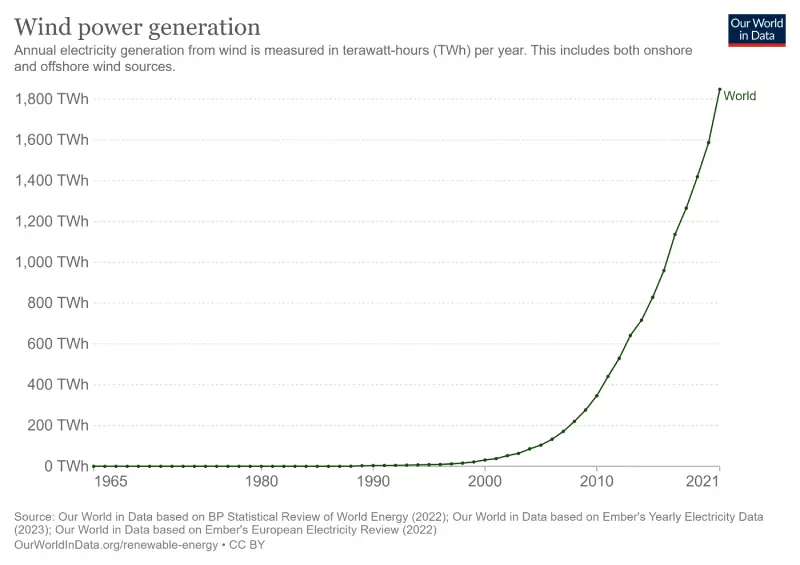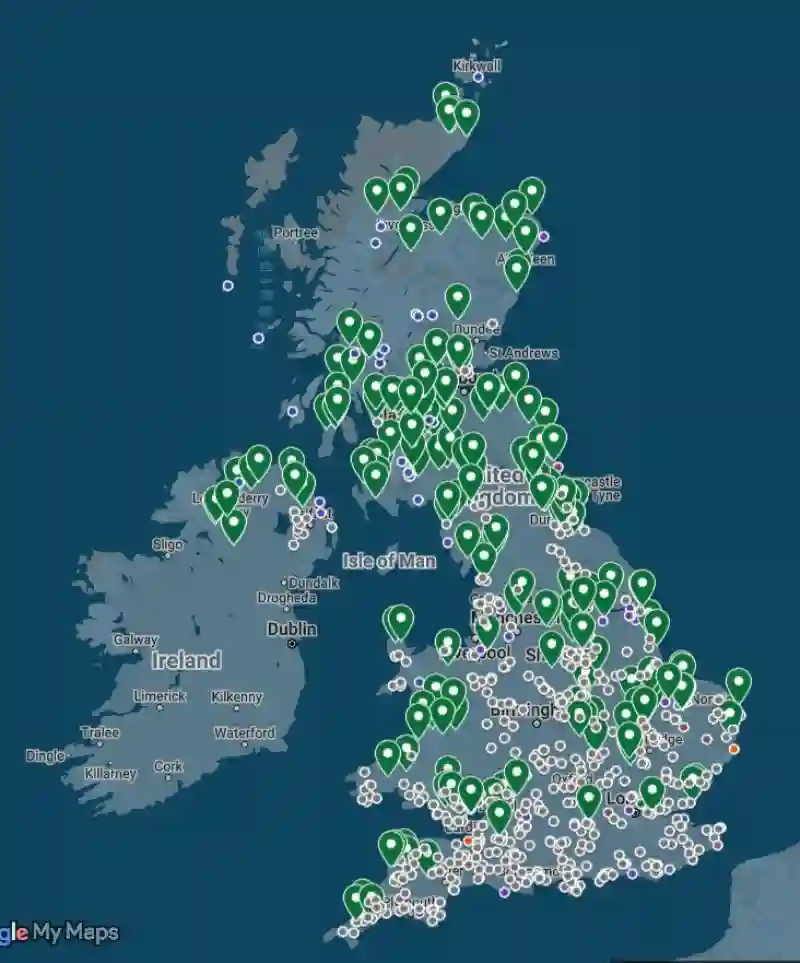A guide to wind energy
Wind power is the fastest-growing renewable energy source in the UK and is expanding rapidly all over the world.
In this guide, we tell you everything you need to know about wind power- including unique insights into the UK’s wind power generation. Let’s dive in.
Contents
- What is wind energy?
- Onshore vs offshore wind power
- The growth of wind power
- The flaws of wind power
- UK wind power data insights
- Conclusion
- External Resources
What is wind energy?

Wind energy is the production of electrical power by harnessing the forces of air flow (i.e. wind) in the lower atmosphere (i.e. within a few hundred meters from the ground). It is a source of renewable energy because winds are expected to continue blowing all throughout out lifetimes.
In almost all cases, wind power is harnessed by groups of wind turbines (i.e. wind farms) installed in an area with a favourable wind resource, where blades can rotate under the influence of consistent winds.
The mechanical rotation of the blades in the wind is converted into electricity using an electrical generator, and the electrical power is then transmitted locally within a distributed grid or more broadly by connecting the turbines to a national grid.
Even though horizontal-axis turbines (i.e. the most common type of turbines) are largely seen as the prime technology to produce wind power, other alternative technologies are more suitable at their niche:
- Vertical-axis turbines, are better suited to small-scale wind energy production and perform better under turbulent winds (i.e. winds close to the ground or within urban areas).
- Airbourne Wind Energy (AWE), which are essentially floating or flying generators that can access more consistent winds at higher elevations and require significantly less materials to build (i.e. flying generators, airbourne kites or gliders pulling on a tether).
- Vortex Bladeless devices, that take advantage of wind turbulence to produce energy by resonating in the wind like guitar strings, taking less space and being highly adaptable.
Onshore vs offshore wind power

There are broadly two categories: onshore (installed on land) and offshore (installed out at sea) wind farms.
Onshore wind farms – are normally situated in flat areas with few obstacles or in elevated locations such as hills or mountain ridges where the wind resource is the most favourable for rotating wind blades consistently, i.e. consistent, non-turbulent winds.
Offshore wind farms – are built on shallow seas with a favourable wind resource and adequate ground to build their underwater foundations. The advantage is that winds are stronger, more consistent and less turbulent on the sea than on land, which translates to offshore farms having much larger power capacities as more, bigger and taller turbines can be built to take advantage of resources.
While onshore wind farms are much cheaper and easier to install and manage, offshore wind farms can access more consistent winds and produce more energy and rarely face any opposition due to them being away from people’s view.
Onshore wind farms can connect to the national grid more easily due to their proximity to existing electrical infrastructure and can be combined with other activities such as agriculture and animal grazing (like commercial solar panels at agrivoltaic farms).
On the other hand, offshore wind farms need to build a connection back onshore so that it can be used for practical purposes such as providing electricity to the grid, or even producing green hydrogen for use in vehicles, industry or as strategic seasonal storage in underground cavities.
The growth of wind power

The roll-out of both onshore and offshore wind energy is growing exponentially as there is global consensus in targetting net-zero emissions by 2050. A large part of global carbon emissions causing climate change comes from generating electricity, making wind energy an attractive alternative as it does not have any operational emissions.
Also, according to our own Levelised-Cost of Electricity (LCOE) calculations (LCOE is the dollar cost of the total electricity produced throughout the lifetime of a power generator), onshore wind energy is generally the cheapest source of electricity to build, making it very attractive for investors. It is expected that the continued growth of UK wind farms will drive down business electricity prices in the future.
The costs keep going down as the production and efficiency of turbines improve, and any negative points, such as the lack of recyclability of its wind blades, are systematically fixed (the first fully-recyclable wind turbines are currently being rolled out)
The flaws of wind power
Despite this exponential growth, wind power still faces many issues, the main one being the fact that wind power is an intermittent source of renewable energy where the amount and timing of electricity being produced cannot be adjusted at free will but is dependent on weather conditions.
In contrast, nuclear energy can consistently produce electricity regardless of the weather, while gas power stations can adjust the amount of power generated to meet the ever-changing demand for electricity in a process called grid re-balancing.
The phasing out of these very useful yet polluting power stations is making the grid operators’ job increasingly difficult, and unfortunately it is NOT a niche that wind energy alone can fill as it cannot produce electricity when it is needed the most.
However, it is not all doom-and-gloom and there is a long-term solution to this problem in the form of:
- Energy Storage – Energy storage solutions such as PSH, CAES, Gravitational Storage, Flywheels and Green Hydrogen mean that excess wind power generation can be stored to meet demand when it is needed and at the correct frequencies.
- International interconnectors mean that electricity can be traded internationally and excess UK wind power can be bought and utilised in another region where it is needed, and renewables generated elsewhere (as far as Morocco within this decade!) will be able to provide electricity to the UK when it is needed.
UK wind power data insights
The UK is one of the global leaders in wind energy and one of the first to generate most of its daily electricity needs during some windy periods.
We have previously covered the role of wind farms in the UK, but here, we present a data-driven analysis using the latest BEIS database of power generation in the UK.
Offshore > onshore when it comes to scaling
The story of commercial wind farms in the UK began in 1992 when a 6.6 MW micro wind farm was inaugurated at the Rhyd y Groes site in Wales. The rest of the 90s saw an explosion of these small (almost symbolic) wind farms all over the UK.
Then, 2004 marked a new era in wind farms as the first pilot offshore wind farm was installed off the Welsh coast in North Hoyle, providing the first 60 MW capacity to the grid.
In 2005, the first >100 MW capacity onshore wind farms came online in Scotland, but the possibility of scaling on land was limited by the limited wind resources available and the lack of visual appeal to many in Britain.
In 2013, it became clear that offshore wind power was the future as the London Array (England) and Gwynt y Mor (Wales) farms together added 1 GW of installed offshore capacity to the grid, which was more than the 30+ onshore farms that came online that year combined.
Offshore wind farm capacity overtook onshore capacity in 2020 and is expected to keep growing much faster as hundreds of state-of-the-art turbines taller than the Eiffel Tower are installed all over the shallows of the British seas.
The combined capacity of all wind farms in the UK is still inferior to that of natural gas by about two-thirds, but 2023 has seen wind power as the main source of electricity in the UK during windy days, while gas capacity remained mostly idle for re-balancing and other tasks.
This comes as no surprise as wind farms are experiencing strong government support while becoming lucrative due to carbon financing and international interconnector capacity, growing the total market it can sell green electricity to through REGOs.
Who owns wind generators in the UK?
Since the UK deregulated the electricity market in the 1990s, ownership of power generators has passed from the state to private and publically owned companies that operate this key infrastructure to turn a profit.
Many think it is predominantly British companies that own the UK’s wind generators, but this is far from the truth as most of the 28 companies’ wind power assets in the country are originally from abroad or global groups.
To demonstrate this, here are a few notes regarding the top 5 wind energy companies in the UK:
- Orsted (Denmark) – Originally an oil and gas company that has recently transitioned into renewables. They own the largest offshore wind farm in the UK: Hornsea 01 (As of 2022!) and a dozen other wind farms.
- Moray Offshore (International) – A joint venture between Engie (France), EDPR (UK) and Diamond Green (China), they own the second largest offshore windfarm of the same name off the coast of Scotland.
- RWE NPower (Germany) – The UK subsidiary of the German energy giant, they own 58 onshore and offshore wind farms across the country (12% of the total), truly conquering the market with numbers.
- Scottish Power Renewables (UK/Spain) – Don’t let the name fool you; Scottish Power is fully owned by the Spanish renewables giant Iberdrola. They have 39 onshore and offshore wind farms to their name in the UK.
- SSE Group (UK) – Formerly known as Scottish and Southern Energy, this is the only fully British company making the top 5. Apart from owning much of the North Sea oil and gas infrastructure, they operate 26 onshore and offshore wind farms in the UK.
Amongst the rest are British, Norwegian, Dutch, Swedish and Italian stakeholders, coming to show how international UK energy generation actually is! A lot of these are also some of the top business energy suppliers.
Bonus: UK wind power facts
Offshore wind facts:
- Northern Ireland has no offshore wind farms, and the vast majority are off the English coast.
- The largest offshore wind farm is Hornsea 01, located off the North East coast of England, with an installed capacity of 1,200MW.
- The smallest offshore wind farm is Gunfleet Sands Demo off the South East coast of England, with an installed capacity of 12 MW.
- The total installed capacity of offshore wind farms is 12.6 GW.
Onshore wind facts:
- Most onshore wind farms are in Scotland (177), with England coming at a close second (171), then Wales (42) and finally NI (28).
- These assets are pretty much evenly distributed across the country, showing the quality of the UK wind resource across the entire territory.

- The largest onshore wind farm is Whitelee in Scotland (322 MW)
- The smallest onshore wind farms are Lynch Knoll and High Down on South West of England (both 0.5 MW)
- The total installed capacity of onshore wind farms is currently 11 GW.
Conclusion
Wind energy is clearly one of the main characters in the fight against climate change, particularly in Northern Europe which has a fantastic wind resource in the North Sea, which is benefitting offshore wind power in particular.
Capacity is growing rapidly thanks to a falling CapEx, increasing efficiency and track record, diversification into different niches besides grid-scale energy, the rise of interconnectors, government incentives and carbon financing.
However, changes in the national grid infrastructure, management and energy storage capabilities are necessary in order for wind power to become a full replacement for fossil fuels.
As of 2021, wind power produces only 7% of global electricity, so there is still a lot of work to do for countries to reach their climate goals.
External Resources
- BEIS DUKES 2022
- ONS GDP Statistics 2022
- Ourworldindata.org
- Orsted
- RWE NPower
- Scottish Power Renewables
- SSE Group
- Wikipedia
- WEF
- The Week

